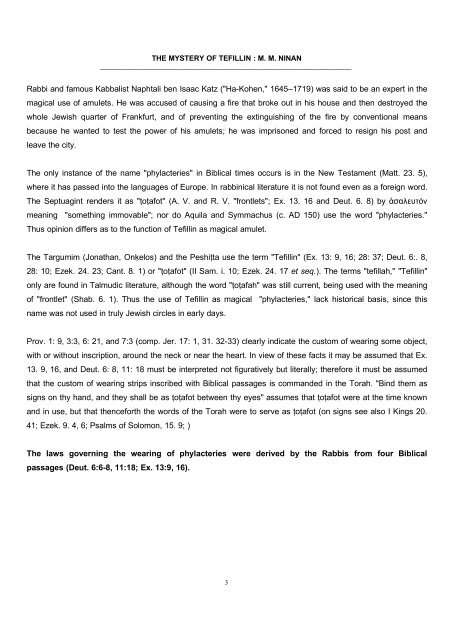Create successful ePaper yourself
Turn your PDF publications into a flip-book with our unique Google optimized e-Paper software.
THE MYSTERY OF TEFILLIN : M. M. NINAN<br />
____________________________________________________________________________<br />
Rabbi and famous Kabbalist Naphtali ben Isaac Katz ("Ha-Kohen," 1645–1719) was said to be an expert in the<br />
magical use <strong>of</strong> amulets. He was accused <strong>of</strong> causing a fire that broke out in his house and then destroyed the<br />
whole Jewish quarter <strong>of</strong> Frankfurt, and <strong>of</strong> preventing the extinguishing <strong>of</strong> the fire by conventional means<br />
because he wanted to test the power <strong>of</strong> his amulets; he was imprisoned and forced to resign his post and<br />
leave the city.<br />
<strong>The</strong> only instance <strong>of</strong> the name "phylacteries" in Biblical times occurs is in the New Testament (Matt. 23. 5),<br />
where it has passed into the languages <strong>of</strong> Europe. In rabbinical literature it is not found even as a foreign word.<br />
<strong>The</strong> Septuagint renders it as "ṭoṭafot" (A. V. and R. V. "frontlets"; Ex. 13. 16 and Deut. 6. 8) by ἀσαλευτόν<br />
meaning "something immovable"; nor do Aquila and Symmachus (c. AD 150) use the word "phylacteries."<br />
Thus opinion differs as to the function <strong>of</strong> Tefillin as magical amulet.<br />
<strong>The</strong> Targumim (Jonathan, Onḳelos) and the Peshiṭta use the term "Tefillin" (Ex. 13: 9, 16; 28: 37; Deut. 6:. 8,<br />
28: 10; Ezek. 24. 23; Cant. 8. 1) or "ṭoṭafot" (II Sam. i. 10; Ezek. 24. 17 et seq.). <strong>The</strong> terms "tefillah," "Tefillin"<br />
only are found in Talmudic literature, although the word "ṭoṭafah" was still current, being used with the meaning<br />
<strong>of</strong> "frontlet" (Shab. 6. 1). Thus the use <strong>of</strong> Tefillin as magical "phylacteries," lack historical basis, since this<br />
name was not used in truly Jewish circles in early days.<br />
Prov. 1: 9, 3:3, 6: 21, and 7:3 (comp. Jer. 17: 1, 31. 32-33) clearly indicate the custom <strong>of</strong> wearing some object,<br />
with or without inscription, around the neck or near the heart. In view <strong>of</strong> these facts it may be assumed that Ex.<br />
13. 9, 16, and Deut. 6: 8, 11: 18 must be interpreted not figuratively but literally; therefore it must be assumed<br />
that the custom <strong>of</strong> wearing strips inscribed with Biblical passages is commanded in the Torah. "Bind them as<br />
signs on thy hand, and they shall be as ṭoṭafot between thy eyes" assumes that ṭoṭafot were at the time known<br />
and in use, but that thenceforth the words <strong>of</strong> the Torah were to serve as ṭoṭafot (on signs see also I Kings 20.<br />
41; Ezek. 9. 4, 6; Psalms <strong>of</strong> Solomon, 15. 9; )<br />
<strong>The</strong> laws governing the wearing <strong>of</strong> phylacteries were derived by the Rabbis from four Biblical<br />
passages (Deut. 6:6-8, 11:18; Ex. 13:9, 16).<br />
3


















